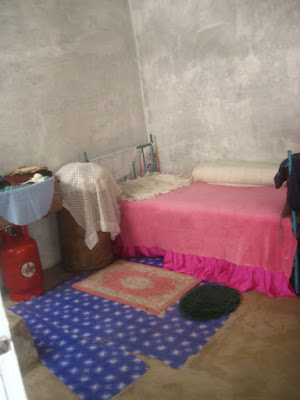Kambimoto: Three Years Later
In the summer of 2011, I was able to return to Nairobi, as a
team member of Mathare Valley slum-upgrading program. I stopped by the Kambimoto upgrading project that I had
documented in the summer of 2008, and found that it has continued to grow,
adapt, and change.
The Kambimoto project was a result of many years of diligent
work by Pamoja Trust working with a small slum in the Mathare Valley, north of
Nairobi. The resulting housing was
incremental, where each family started with a basic one bedroom, one-story
space that could eventually be expanded vertically up to three stories. In 2008, the project was still under
construction, although many units had been completed and families had moved in. In 2011, the entire project was still
under development due to lack of funds, but many individual units had been
expanded and the overall space had been transformed significantly.
Based on observation, about a third of the occupied units
had added at least one story, if not two stories to their units. Additionally, color, and articulation
had begun to appear on many units.
In one case, neighbors worked together on colors, relief, and surface
articulation to add identity and individualization to their homes, while still
maintaining a collective identity.
Gates and fences had been added in a number of cases to porches that
were on ground level.
Generally speaking, most people followed basic design and
material guidelines as they expanded vertically. In some cases, make shift additions and roofs were cobbled
together with rudimentary materials, alluding to the slums and physical
conditions that many of these families had moved on from. This was a concern from the beginning
and a reason why the additions were supposed to uniform. Regardless, one of the architects
working on the project remained proud of the project to provide low cost and
accessible housing, but was frustrated that part of it was beginning to look
trashy. Additionally, he mentioned
that one of the biggest challenges was that people didn’t have incomes, and in
many cases were unable to afford any additions or had to depend on very low cost
and low quality materials.
The public spaces and interstitial spaces are surprisingly
well-kept, clean, and inviting.
Small plants and mini gardens have sprouted up, and because water and
sewer lines were added and are underground, there are now walkways that provide
solid surface which can be cleaned.
The difference in the quality of space in Kambimoto with that of the
informal housing one block away is quite extraordinary.
The only real criticism people living there have of the
project is that the units were not designed to be able to rent out space. Accessing the stairway requires moving
through the living room, so it makes it very difficult to rent out an upper
room/floor and still maintain privacy.
Fortunately, future projects that are in the works are being designed to
allow the stair to have a separate entrance from the street. Finally, there is not enough space in
the units to allow any businesses of enterprises to operate from inside. Consequently, the ubiquitous street
stalls have popped up in one of the newly widened streets.
Overall, this project continues to be an inspiration and
successful on many levels. It was
great to return and see that units were expanding, and that the entire
community, while still struggling, is maturing and growing.












Comments
House Extension in Balham
I was searching over search engines and found your blog site.
Well i like your high quality blog site design plus your posting abilities.
Keep doing it.
dwell east end adelaide
house movers in Islamabad
https://www.lcrenovation.co.uk/loft-conversion-in-battersea/
House Renovations in Battersea
https://www.lcrenovation.co.uk/loft-conversion-in-battersea/
House Renovations in Battersea